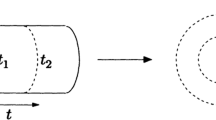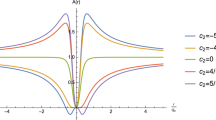Abstract
In frames of the nonlocal and nonpolynomial quantum theory of the one component scalar field in \(D\)-dimensional spacetime, stated by G.V. Efimov, the expansion of the \(\mathcal{S}\)-matrix is revisited for different interaction Lagrangians and for some kinds of Gaussian propagators modified by different ultraviolet form factors \(F\) which depend on some length parameter \(l\). The expansion of the \(\mathcal{S}\)-matrix is of the form of a grand canonical partition function of some \((D + N)\)-dimensional (\(N \geqslant 1\)) classical gas with interaction. The toy model of the realistic quantum field theory (QFT) is considered where the \(\mathcal{S}\)-matrix is calculated in closed form. Then, the functional Schwinger–Dyson and Schrödinger equations for the \(\mathcal{S}\)-matrix in Efimov representation are derived. These equations play a central role in the present paper. The functional Schwinger–Dyson and Schrödinger equations in Efimov representation do not involve explicit functional derivatives but involve a shift of the field which is the \(\mathcal{S}\)-matrix argument. The asymptotic solutions of the Schwinger–Dyson equation are obtained in different limits. Also, the solution is found in one heuristic case allowing us to study qualitatively the behavior of the \(\mathcal{S}\)-matrix for an arbitrary finite value of its argument. Self-consistency equations, which arise during the process of derivation, are of a great interest. Finally, in the light of the discussion of QFT functional equations, ultraviolet form factors and extra dimensions, the connection with functional (in terms of the Wilson–Polchinski and Wetterich–Morris functional equations) and holographic renormalization groups (in terms of the functional Hamilton–Jacobi equation) is made. In addition the Hamilton–Jacobi equation is formulated in an unconventional way.
Similar content being viewed by others
REFERENCES
G. V. Efimov, “Essentially nonlinear interaction Lagrangians and nonlocalized quantum field theory,” Theor. Math. Phys. 2, 26–40 (1970).
G. V. Efimov, “Nonlocal quantum field theory, nonlinear interaction Lagrangians, and convergence of the perturbation theory series,” Theor. Math. Phys. 2, 217–223 (1970).
G. V. Efimov, “On the proof that the scattering matrix is unitary,” Theor. Math. Phys. 25, 951–957 (1975).
D. Ya. Petrina and V. I. Skripnik, “Kirkwood–Salzburg equations for the coefficient functions of the S matrix,” Theor. Math. Phys. 8, 896–904 (1971).
A. L. Rebenko, “On equations for the matrix elements of Euclidean quantum electrodynamics,” Theor. Math. Phys. 11, 525–536 (1972).
A. G. Basuev, “Convergence of the perturbation series for a nonlocal nonpolynomial theory,” Theor. Math. Phys. 16, 835–842 (1973).
A. G. Basuev, “Convergence of the perturbation series for the Yukawa interaction,” Theor. Math. Phys. 22, 142–148 (1975).
G. V. Efimov, Nonlocal Interactions of Quantized Fields (Nauka, Moscow, 1977) [in Russian].
G. V. Efimov, Problems of the Quantum Theory of Nonlocal Interactions (Nauka, Moscow, 1985) [in Russian].
G. V. Efimov, “Blokhintsev and nonlocal quantum field theory,” Phys. Part. Nucl. 35, 598–618 (2004).
B. P. Kosyakov, Introduction to the Classical Theory of Particles and Fields (Berlin–Heidelberg, Springer, 2007).
G. V. Efimov, “Nonlocal quantum theory of the scalar field,” Commun. Math. Phys. 5, 42–56 (1967).
G. V. Efimov and V. A. Alebastrov, “A proof of the unitarity of scattering matrix in a nonlocal quantum field theory,” Commun. Math. Phys. 31, 1–24 (1973).
G. V. Efimov and V. A. Alebastrov, “Causality in quantum field theory with nonlocal interaction,” Commun. Math. Phys. 38, 11–28 (1974).
G. V. Efimov, “Strong coupling in the quantum field theory with nonlocal nonpolynomial interaction,” Commun. Math. Phys. 57, 235–258 (1977).
G. V. Efimov, “Vacuum energy in gφ4 theory for g → ∞,” Commun. Math. Phys. 65, 15–44 (1979).
G. V. Efimov, “Amplitudes in nonlocal theories at high energies,” Theor. Math. Phys. 128, 1169–1175 (2001).
P. Kopietz, L. Bartosch, and F. Schütz, Introduction to the Functional Renormalization Group (Berlin–Heidelberg, Springer, 2010).
A. Wipf, Statistical Approach to Quantum Field Theory (Berlin–Heidelberg, Springer, 2013).
O. J. Rosten, “Fundamentals of the exact renormalization group,” Phys. Rep. 511, 177–272 (2012).
Y. Igarashi, K. Itoh, and H. Sonoda, “Realization of symmetry in the ERG approach to quantum field theory,” Prog. Theor. Phys. Suppl. 181, 1–166 (2009).
N. N. Bogoliubov and D. V. Shirkov, Introduction to the Theory of Quantized Fields (John Wiley and Sons Inc., 1980).
N. N. Bogoliubov and D. V. Shirkov, Quantum Fields (Benjiamin/Cummings Publ. Co., 1983).
A. N. Vasiliev, Functional Methods in Quantum Field Theory and Statistical Physics (Gordon and Breach Sci. Publ., 1998).
A. N. Vasiliev, The Field Theoretic Renormalization Group in Critical Behavior Theory and Stochastic Dynamics (Chapman and Hall/CRC, Boca Raton, FL, 2004).
J. Zinn-Justin, Quantum Field Theory and Critical Phenomena (Clarendon, Oxford, UK, 1989).
A. M. Polyakov, Gauge Fields and Strings (Harwood Acad. Publ. GmbH, Chur, Switzerland, 1987).
A. M. Polyakov, “Quark confinement and topology of gauge theories,” Nucl. Phys. B 120, 429–458 (1977).
Stu Samuel, “Grand partition function in field theory with applications to sine-Gordon field theory,” Phys. Rev. D 18, 1916 (1978).
L. O’Raifeartaigh, J. M. Pawlowski, and V. V. Sreedhar, “Duality in quantum Liouville theory,” Ann. Phys. 277, 117–143 (1999).
P. Dutta, “Schwinger–Dyson approach to Liouville field theory,” Theor. Math. Phys. 187, 899–908 (2016).
J. M. Maldacena, “The large-N limit of superconformal field theories and supergravity,” Int. J. Theor. Phys. 38, 1113–1133 (1999).
E. Witten, “Anti-de Sitter space and holography,” Adv. Theor. Math. Phys. 2, 253–291 (1998).
S. S. Gubser, I. R. Klebanov, and A. M. Polyakov, “Gauge theory correlators from non-critical string theory,” Phys. Lett. B 428, 105–114 (1998).
E. T. Akhmedov, “A remark on the AdS/CFT correspondence and the renormalization group flow,” Phys. Lett. B 442 (1–4), 152–158 (1998).
J. de Boer, E. Verlinde, and H. Verlinde, “On the holographic renormalization group,” J. High Energy Phys., No. 08, 003 (2000).
E. Verlinde and H. Verlinde, “RG-flow, gravity and the cosmological constant,” J. High Energy Phys., No. 05, 034 (2000).
M. Fukuma, S. Matsuura, and T. Sakai, “Holographic renormalization group,” Prog. Theor. Phys. 4, 489–562 (2003).
J. M. Lizana, T. R. Morris, and M. Pérez-Victoria, “Holographic renormalisation group flows and renormalisation from a Wilsonian perspective,” J. High Energy Phys., No. 03, 198 (2016).
E. T. Akhmedov, “Notes on multi-trace operators and holographic renormalization group” (2002), arXiv: hep-th/0202055.
E. T. Akhmedov, I. B. Gahramanov, and E. T. Musaev, “Hints on integrability in the Wilsonian/holographic renormalization group,” JETP Lett. 93, 545–550 (2011).
I. Heemskerk and J. Polchinski, “Holographic and Wilsonian renormalization groups,” J. High Energy Phys., No. 06, 031 (2011).
Luisa Doplicher, “Generalized Tomonaga–Schwinger equation from the Hadamard formula,” Phys. Rev. D 70, 064037 (2004).
A. G. Basuev and A. N. Vasil’ev, “Method of summing the perturbation series in scalar theories,” Theor. Math. Phys. 18, 129–135 (1974).
V. V. Belokurov, Yu. P. Solov’ev, and E. T. Shavgulidze, “Perturbation theory with convergent series: I. Toy models,” Theor. Math. Phys. 109, 1287–1293 (1996).
V. V. Belokurov, Yu. P. Solov’ev, and E. T. Shavgulidze, “Perturbation theory with convergent series: II. Functional integrals in Hilbert space,” Theor. Math. Phys. 109, 1294–1301 (1996).
L. D. Korsun, A. N. Sisakyan, and I. L. Solovtsov, “Variational perturbation theory. The φ2k oscillator,” Theor. Math. Phys. 90, 22–34 (1992).
E. S. Fradkin, “Application of functional methods in quantum field theory and quantum statistics: (I). Divergence-free field theory with local nonlinear interaction,” Nucl. Phys. 49, 624–640 (1963).
E. S. Fradkin, “Application of functional methods in quantum field theory and quantum statistics: (II),” Nucl. Phys. 76, 588–624 (1966).
E. S. Fradkin, Selected Papers on Theoretical Physics (Papers in English and Russian) (Nauka, Moscow, 2007).
G. V. Efimov, “Construction of a local quantum field theory without ultraviolet divergences,” J. Exp. Theor. Phys. 17, 1417–1423 (1963).
G. V. Efimov, “Nonlinear interaction Lagrangians,” J. Exp. Theor. Phys. 21, 395–401 (1965).
M. K. Volkov, “Quantum field model with unrenormalizable interaction,” Commun. Math. Phys. 7, 289–304 (1968).
M. K. Volkov, “Green functions in the theory of local unrenormalizable interactions,” Commun. Math. Phys. 15, 69–82 (1969).
B. W. Lee and B. Zumino, “Some considerations on the Efimov–Fradkin method in nonlinear field theories,” Nucl. Phys. B 13, 671–686 (1969).
R. Delbourgo, A. Salam, and J. Strathdee, “Infinities of nonlinear and Lagrangian theories,” Phys. Rev. 187, 1999 (1969).
A. Salam and J. Strathdee, “Momentum-space behavior of integrals in nonpolynomial Lagrangian theories,” Phys. Rev. D 1, 3296 (1970).
D. I. Fivel and P. K. Mitter, “Theory of weak interactions without divergences,” Phys. Rev. D 1, 3270 (1970).
S. Graffi and V. Grecchi, “Asymptotic expansions and nonlinear field theories,” Phys. Rev. D 6, 493 (1972).
Z. Horvath and G. Pocsik, “High-energy summation of ladder diagrams in nonpolynomial field theories,” Ann. Phys. 74, 555–566 (1972).
M. La Camera and A. Wataghin, “Nonpolynomial interactions at high energies,” Nuovo Cimento A, 17, 526–534 (1973).
S. N. Biswas, G. P. Malik, and E. C. G. Sudarshan, “Superpropagator for a nonpolynomial field,” Phys. Rev. D 7, 2884 (1973).
ACKNOWLEDGMENTS
The authors are deeply grateful to their families for love, wisdom and understanding. We are very grateful to Artem A. Alexandrov for his help in typing the paper. Also, we express special gratitude to Sergey E. Kuratov and Alexander V. Andriyash for supporting this research at an early stage at the Center for Fundamental and Applied Research (Dukhov Research Institute of Automatics). Finally, we are very grateful to Reviewer for many valuable comments and advice on this paper.
Author information
Authors and Affiliations
Corresponding authors
Additional information
In Memory of Gariy Vladimirovich Efimov
Rights and permissions
About this article
Cite this article
Guskov, V.A., Ivanov, M.G. & Ogarkov, S.L. A Note on Efimov Nonlocal and Nonpolynomial Quantum Scalar Field Theory. Phys. Part. Nuclei 52, 420–437 (2021). https://doi.org/10.1134/S1063779621030059
Received:
Revised:
Accepted:
Published:
Issue Date:
DOI: https://doi.org/10.1134/S1063779621030059




